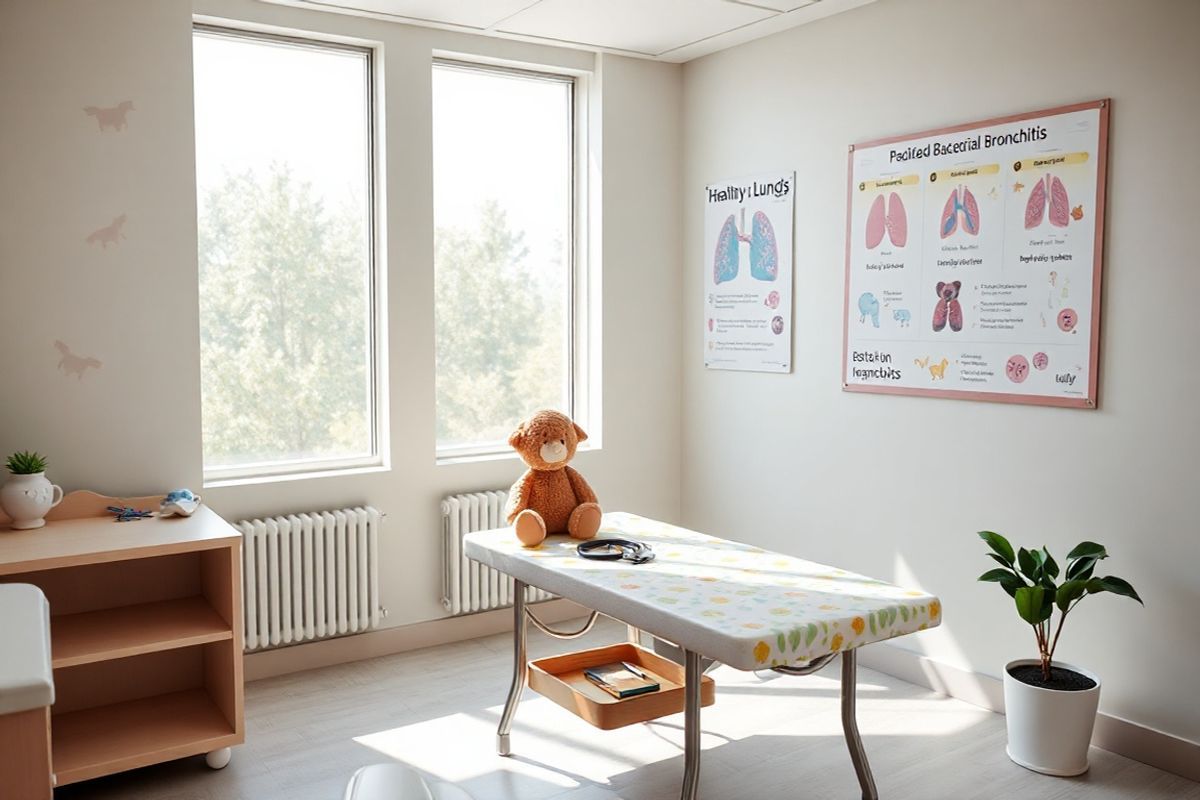Table of Contents
The Hidden Threat of Protracted Bacterial Bronchitis: Recognizing the Symptoms

PBB often manifests as a wet cough that is persistent and may worsen during the night or with physical activity. Other symptoms may include:
- Excessive mucus production
- Wheezing or difficulty breathing
- Fatigue or irritability
- Recurrent respiratory infections
Research indicates that approximately 40% of children with a chronic wet cough are found to have PBB, making it a common yet critical condition to recognize early (Healthline, 2023). The cough may be accompanied by crackles or wheezing sounds, which can be observed during a physician’s examination (Cleveland Clinic, 2024).
Causes Behind Persistent Wet Cough: What You Need to Know
PBB is primarily caused by bacterial infections, with common pathogens including:
- Haemophilus influenzae
- Streptococcus pneumoniae
- Moraxella catarrhalis
Several contributing factors can predispose individuals to develop PBB, such as:
- Defects in immune function: Weak or abnormal immune responses can hinder the body’s ability to combat infections effectively.
- Structural abnormalities in the airways: Physical issues may create an environment conducive to bacteria growth, leading to chronic infections.
- Bacterial biofilm formation: Bacteria can form protective clusters that resist treatment, making eradication more challenging.
- Impaired airway clearance: A reduced ability to clear mucus and pathogens can result in ongoing infections.
Notably, PBB is more prevalent in young children under the age of 2, particularly those who attend daycare or have a history of chronic cough (Healthline, 2023).
Diagnosing Protracted Bacterial Bronchitis: Tests and Procedures Explained

Diagnosing PBB typically involves a thorough medical history and physical examination. Healthcare professionals may utilize various diagnostic tools, including:
- Chest X-rays or CT scans: These imaging tests can help identify any structural abnormalities in the lungs or the presence of infections.
- Sputum culture: This test helps determine the specific bacteria responsible for the infection, guiding antibiotic treatment.
- Bronchoscopy: In some cases, this invasive procedure may be performed to visualize the airways and collect samples for analysis.
Early diagnosis is crucial, as untreated PBB can lead to complications such as bronchiectasis, characterized by chronic inflammation and damage to the airways (Cleveland Clinic, 2024).
Effective Treatments for Protracted Bacterial Bronchitis: Managing Your Symptoms
Treatment for PBB generally requires a course of antibiotics, often prescribed for 2 to 6 weeks. Common antibiotics used include:
- Amoxicillin-clavulanate
- Trimethoprim-sulfamethoxazole
- Cefdinir
More than 60% of PBB cases resolve with appropriate antibiotic therapy. If symptoms persist despite treatment, hospitalization may be necessary for further interventions such as bronchoscopy and intravenous antibiotics (Healthline, 2023).
TablCommon Antibiotics Prescribed for PBB
| Antibiotic | Typical Usage |
|---|---|
| Amoxicillin-clavulanate | First-line treatment |
| Trimethoprim-sulfamethoxazole | Alternative if resistant |
| Cefdinir | Used based on culture results |
In addition to antibiotics, airway clearance techniques such as chest physiotherapy and nebulizer treatments may be employed to help loosen mucus, making coughing more productive and comfortable.
Prevention Strategies for Protracted Bacterial Bronchitis: Keeping Your Lungs Healthy
Preventing PBB involves several strategies aimed at reducing the risk of respiratory infections:
- Vaccination: Staying up to date with vaccinations, such as the pneumococcal vaccine, can help prevent infections that may lead to PBB.
- Hygiene Practices: Regular handwashing and avoiding exposure to sick individuals can reduce the risk of infections.
- Healthy Environment: Maintaining an environment with good air quality and reducing exposure to pollutants can support lung health.
Educating caregivers about recognizing early signs of respiratory infections can lead to timely medical intervention and potentially prevent the development of PBB.
Frequently Asked Questions (FAQ)
1. Can protracted bacterial bronchitis resolve on its own?
No, PBB generally does not resolve without treatment. Without antibiotics, it can lead to inflammation and damage to the airways.
2. What should I do if my child’s cough persists?
Consult a healthcare professional to evaluate the cause of the persistent cough. Early intervention is crucial.
3. Are antibiotics always necessary for treating PBB?
Yes, antibiotics are the primary treatment for PBB, as this condition is caused by bacterial infections.
4. What are the long-term effects of untreated PBB?
Untreated PBB can lead to chronic lung conditions, such as bronchiectasis, which may cause permanent damage to the airways.
5. Are there any home remedies for managing wet cough?
While antibiotics are necessary for treating PBB, supportive care such as staying hydrated, using a humidifier, and practicing airway clearance techniques can help manage symptoms.
References
- Protracted Bacterial Bronchitis: Causes, Symptoms, and Treatments. Retrieved from https://www.healthline.com/health/protracted-bacterial-bronchitis
- Chronic cough - Symptoms and causes. Retrieved from https://www.mayoclinic.org/diseases-conditions/chronic-cough/symptoms-causes/syc-20351575
- Cough: Causes, Diagnosis, Treatment & Conditions. Retrieved from https://my.clevelandclinic.org/health/symptoms/17755-cough
- Wet Cough: Types, Causes, Diagnosis, Treatment and More. Retrieved from https://www.health.com/condition/cold/wet-cough
- Wet cough: What it means, treatments, and more. Retrieved from https://www.medicalnewstoday.com/articles/327442









